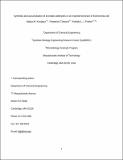| dc.contributor.author | Kunjapur, Aditya Mohan | |
| dc.contributor.author | Tarasova, Yekaterina | |
| dc.contributor.author | Prather, Kristala L | |
| dc.date.accessioned | 2019-10-17T20:33:16Z | |
| dc.date.available | 2019-10-17T20:33:16Z | |
| dc.date.issued | 2014-07 | |
| dc.date.submitted | 2014-02 | |
| dc.identifier.issn | 0002-7863 | |
| dc.identifier.issn | 1520-5126 | |
| dc.identifier.uri | https://hdl.handle.net/1721.1/122618 | |
| dc.description.abstract | Aromatic aldehydes are useful in numerous applications, especially as flavors, fragrances, and pharmaceutical precursors. However, microbial synthesis of aldehydes is hindered by rapid, endogenous, and redundant conversion of aldehydes to their corresponding alcohols. We report the construction of an Escherichia coli K-12 MG1655 strain with reduced aromatic aldehyde reduction (RARE) that serves as a platform for aromatic aldehyde biosynthesis. Six genes with reported activity on the model substrate benzaldehyde were rationally targeted for deletion: three genes that encode aldo-keto reductases and three genes that encode alcohol dehydrogenases. Upon expression of a recombinant carboxylic acid reductase in the RARE strain and addition of benzoate during growth, benzaldehyde remained in the culture after 24 h, with less than 12% conversion of benzaldehyde to benzyl alcohol. Although individual overexpression results demonstrated that all six genes could contribute to benzaldehyde reduction in vivo, additional experiments featuring subset deletion strains revealed that two of the gene deletions were dispensable under the conditions tested. The engineered strain was next investigated for the production of vanillin from vanillate and succeeded in preventing formation of the byproduct vanillyl alcohol. A pathway for the biosynthesis of vanillin directly from glucose was introduced and resulted in a 55-fold improvement in vanillin titer when using the RARE strain versus the wild-type strain. Finally, synthesis of the chiral pharmaceutical intermediate l-phenylacetylcarbinol (l-PAC) was demonstrated from benzaldehyde and glucose upon expression of a recombinant mutant pyruvate decarboxylase in the RARE strain. Beyond allowing accumulation of aromatic aldehydes as end products in E. coli, the RARE strain expands the classes of chemicals that can be produced microbially via aldehyde intermediates. | en_US |
| dc.language.iso | en | |
| dc.publisher | American Chemical Society (ACS) | en_US |
| dc.relation.isversionof | http://dx.doi.org/10.1021/ja506664a | en_US |
| dc.rights | Article is made available in accordance with the publisher's policy and may be subject to US copyright law. Please refer to the publisher's site for terms of use. | en_US |
| dc.source | Prof. Prather | en_US |
| dc.title | Synthesis and Accumulation of Aromatic Aldehydes in an Engineered Strain ofEscherichia coli | en_US |
| dc.type | Article | en_US |
| dc.identifier.citation | Kunjapur, Aditya et al. "Synthesis and Accumulation of Aromatic Aldehydes in an Engineered Strain of Escherichia coli." Journal of American Chemical Society 136, 33 (July 2014): 11644-11654 © 2014 American Chemical Society | en_US |
| dc.contributor.department | Massachusetts Institute of Technology. Department of Chemical Engineering | en_US |
| dc.contributor.department | Massachusetts Institute of Technology. Synthetic Biology Center | en_US |
| dc.contributor.department | Massachusetts Institute of Technology. Microbiology Graduate Program | en_US |
| dc.relation.journal | Journal of the American Chemical Society | en_US |
| dc.eprint.version | Author's final manuscript | en_US |
| dc.type.uri | http://purl.org/eprint/type/JournalArticle | en_US |
| eprint.status | http://purl.org/eprint/status/PeerReviewed | en_US |
| dc.date.updated | 2019-10-10T13:09:48Z | |
| dspace.date.submission | 2019-10-10T13:09:51Z | |
| mit.journal.volume | 136 | en_US |
| mit.journal.issue | 33 | en_US |
